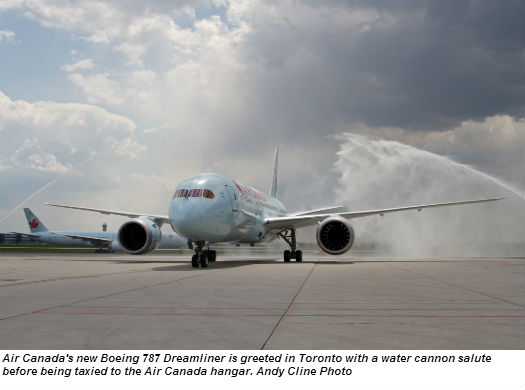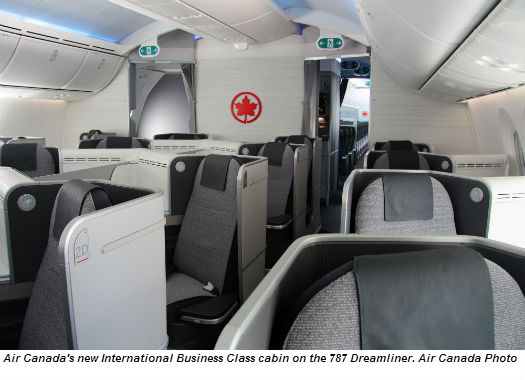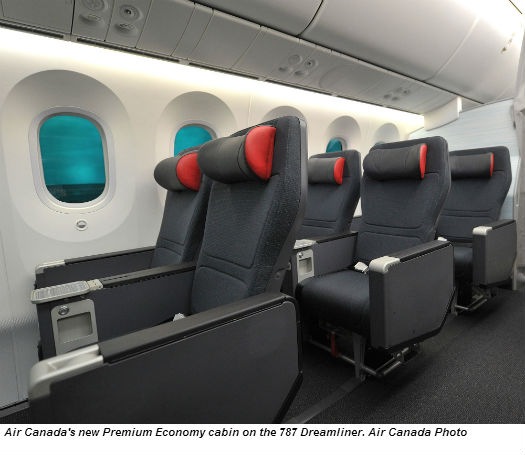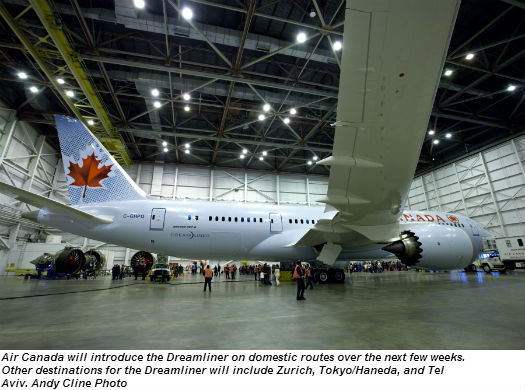Estimated reading time 5 minutes, 22 seconds.
Air Canada’s first Boeing 787 Dreamliner arrived in Toronto on May 18, after the airline officially took possession of the aircraft at Boeing’s factory near Seattle, Wash. Close to 100 Air Canada executives and employees were on board for the delivery flight. The brand new jet was greeted in Toronto with a water cannon salute before it was taxied to the Air Canada hangar, where preparations were underway for a full slate of celebrations. The airline hosted employee tours over the long weekend and an open house on May 20, with VIP customers and members of the media invited to see the new aircraft.
The Dreamliner is heralded as a game-changing addition to the Air Canada fleet. The airline has 37 of them on order (15 787-8 aircraft and 22 of the larger 787-9 jets), at a total cost of $6 billion. The new Dreamliners—which should all be online by the end of 2019—are destined to replace Air Canada’s existing Boeing 767-300ER and Airbus A330 fleets. The airline expects to save about 20 per cent in fuel and maintenance costs compared to its current fleet.
The arrival of the first Dreamliner also provided the public with a look at the interior design Air Canada calls its “new international standard.” Featuring three cabins of service—international business class (20 seats); premium economy (21 seats); and economy (210 seats)—the Dreamliner incorporates a variety of new features designed to enhance passenger comfort.
In the front of the aircraft, business class passengers are ensconced in lie-flat executive pods, featuring massaging headrests, an 18-inch personal entertainment screen with touch handset, and other amenities such as Universal power and USB outlets.
Air Canada’s new premium economy section is unique in North America, with passengers offered a selection of premium meals, complimentary bar service, priority check-in, 10.6-inch entertainment screens, and 19.5-inch wide seats (with a full 38 inches of legroom and a 7-inch recline).
The economy cabin is laid out in a 3-3-3 configuration, “offering personal space consistent with the comfort of Air Canada’s current economy cabins on other aircraft.” Each seat has a 9-inch personal entertainment touch screen.
Boeing redesigned the overhead bins throughout the aircraft as well, with each able to accommodate four roller bags placed on their sides, with a combined weight up to 110 pounds (50 kilograms). Cabin air is supposed to be fresher as well, thanks to fresh air “scoops” on the side of the fuselage and additional filtration systems. For enhanced passenger comfort, the cabin has been pressurized to a maximum altitude of 6,000 feet, compared to about 8,000 feet on other passenger jets. To help reduce jet lag, Boeing’s interior cabin LED lighting can also be adjusted to replicate a full flying day, gradually changing from “day” to “night” during longer flights.
Perhaps one of the most talked-about features of Air Canada’s new Dreamliner is the electrochromatic window shades. Controlled by individual switches, it takes less than a minute for the windows—which are 30 per cent larger than those on other aircraft—to steadily darken until they black out all light.
In conjunction with the arrival of the Dreamliner, Air Canada also announced it has adopted a new branding campaign, summed up by the new tagline, “Your world awaits.” In 2009, the airline announced its plan to compete with the world’s best air carriers, and said that several elements of that strategy are now in place, including the introduction of premium economy service for international travel.
Air Canada will introduce the Dreamliner on select domestic routes over the next few weeks, with its inaugural revenue flight scheduled to be Toronto-Halifax on May 23. Staff also said Zurich is a planned transatlantic destination as Dreamliners are gradually introduced into the fleet. The 787’s first dedicated route will be Toronto-Tokyo/Haneda in July, followed by Toronto-Tel Aviv later in the summer, and then Vancouver to Tokyo as well as Shanghai over the winter.
In late 2015, Air Canada also plans to begin converting 12 Boeing 777-300ER and six 777-200LR aircraft to three-class interior configurations that are consistent with the 787 Dreamliner.







